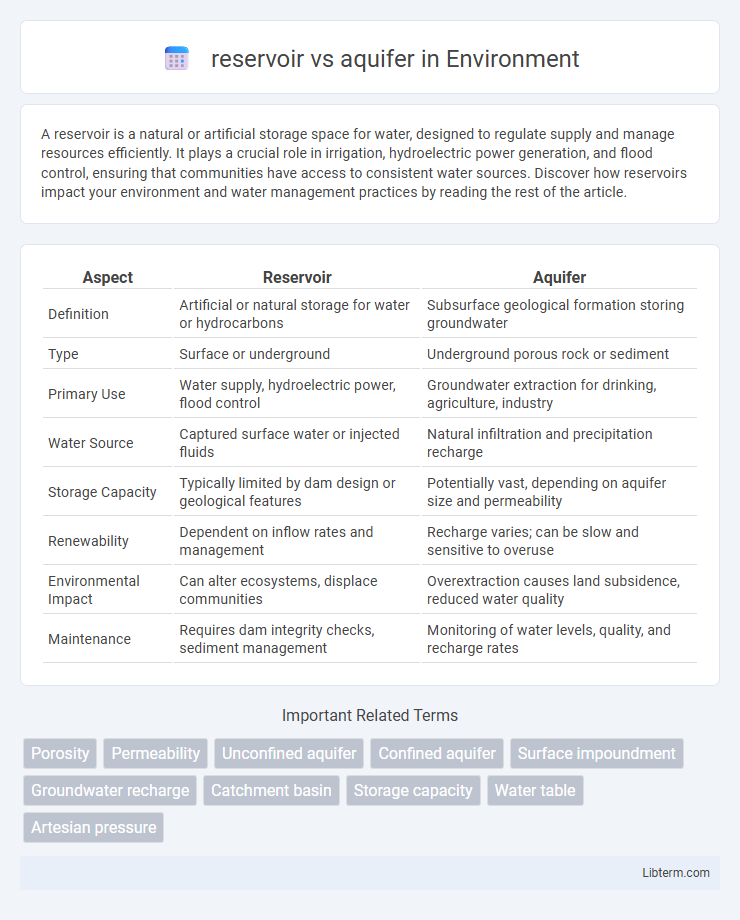A reservoir is a natural or artificial storage space for water, designed to regulate supply and manage resources efficiently. It plays a crucial role in irrigation, hydroelectric power generation, and flood control, ensuring that communities have access to consistent water sources. Discover how reservoirs impact your environment and water management practices by reading the rest of the article.
Table of Comparison
| Aspect | Reservoir | Aquifer |
|---|---|---|
| Definition | Artificial or natural storage for water or hydrocarbons | Subsurface geological formation storing groundwater |
| Type | Surface or underground | Underground porous rock or sediment |
| Primary Use | Water supply, hydroelectric power, flood control | Groundwater extraction for drinking, agriculture, industry |
| Water Source | Captured surface water or injected fluids | Natural infiltration and precipitation recharge |
| Storage Capacity | Typically limited by dam design or geological features | Potentially vast, depending on aquifer size and permeability |
| Renewability | Dependent on inflow rates and management | Recharge varies; can be slow and sensitive to overuse |
| Environmental Impact | Can alter ecosystems, displace communities | Overextraction causes land subsidence, reduced water quality |
| Maintenance | Requires dam integrity checks, sediment management | Monitoring of water levels, quality, and recharge rates |
Introduction to Reservoirs and Aquifers
Reservoirs are engineered structures designed to store surface water for irrigation, drinking, and industrial use, whereas aquifers are natural underground layers of permeable rock or sediment that hold groundwater. Reservoirs typically rely on dams to capture runoff, while aquifers supply water through subsurface flow and are accessed via wells. Understanding the distinct roles and mechanisms of reservoirs and aquifers is essential for sustainable water resource management and planning.
Definitions: What Is a Reservoir? What Is an Aquifer?
A reservoir is a man-made or natural storage space for water, often created by constructing dams or other barriers to collect surface water for supply, irrigation, or hydroelectric power. An aquifer is a geological formation of permeable rock, sand, or gravel that stores and transmits groundwater through its pores and fractures. While reservoirs hold surface water, aquifers function as underground water sources essential for wells and natural springs.
Natural vs. Man-Made Water Storage
Reservoirs are man-made water storage systems created by constructing dams across rivers or streams, designed to store and regulate surface water for purposes like irrigation, hydroelectric power, and municipal supply. Aquifers are natural underground layers of porous rock or sediment that accumulate and transmit groundwater, serving as vital sources for wells and springs. Unlike reservoirs, aquifers rely on natural processes such as precipitation infiltration and gravity-driven flow to replenish water stores.
Geological Formation and Structure
Reservoirs are human-made or natural surface structures designed to store water, often created by damming rivers, whereas aquifers are underground geological formations composed of permeable rock, sand, or gravel that store and transmit groundwater. Aquifers rely on porous and permeable materials like sandstone or fractured limestone to hold water within their pore spaces, making them crucial natural water sources. Reservoirs typically involve engineered containment with concrete or earthen dams, while aquifers function through subsurface hydrogeological processes governed by rock permeability and porosity.
Water Storage Capacity and Accessibility
Reservoirs typically offer greater controllable water storage capacity, designed for surface water collection and management, allowing easy access through engineered outlets and infrastructure. Aquifers store vast volumes of groundwater naturally in permeable rock or sediment formations, providing significant but less immediately accessible water, often requiring pumping for extraction. The efficiency of accessing water from reservoirs surpasses aquifers due to direct surface access, while aquifers provide more sustainable, long-term storage less affected by evaporation.
Methods of Water Extraction and Distribution
Reservoirs store surface water collected behind dams and utilize gravity-fed channels or pipelines for controlled distribution to urban areas and irrigation systems. Aquifers, underground layers of permeable rock or sediment, require extraction methods like wells and pumps to withdraw groundwater for agricultural, industrial, and municipal use. Advanced techniques, including borehole drilling and managed aquifer recharge, enhance sustainable water extraction and distribution from aquifers while minimizing depletion risks.
Environmental Impact and Sustainability
Reservoirs, often created by damming rivers, significantly alter local ecosystems by flooding large areas, disrupting wildlife habitats, and affecting water temperature and flow patterns. Aquifers, on the other hand, store groundwater naturally and are less intrusive but face sustainability challenges due to over-extraction leading to depletion and land subsidence. Sustainable water management requires balancing reservoir use for controlled surface water storage with aquifer recharge practices to maintain groundwater levels and protect ecosystems.
Typical Uses: Agriculture, Industry, and Drinking Water
Reservoirs are engineered structures designed to store surface water for irrigation in agriculture, industrial processes, and municipal drinking supplies, providing controlled water availability during dry periods. Aquifers, natural underground layers of water-bearing permeable rock or sediment, supply groundwater essential for agricultural irrigation, industrial cooling, and potable water, especially in regions lacking surface reservoirs. Both reservoirs and aquifers are critical components of integrated water resource management strategies to meet diverse demands across sectors.
Advantages and Disadvantages: Reservoirs vs. Aquifers
Reservoirs offer controlled water storage with easy accessibility for irrigation, hydroelectric power, and urban supply but face drawbacks like high evaporation rates, environmental disruption, and costly construction. Aquifers provide natural underground water storage with minimal surface impact and lower evaporation, supporting sustainable withdrawal when managed well, yet they are vulnerable to contamination, over-extraction, and slower recharge rates. Balancing reservoirs and aquifers depends on regional water demand, geological conditions, and long-term sustainability goals.
Future Perspectives and Water Resource Management
Advancements in remote sensing and geospatial technologies are enhancing the monitoring and management of reservoirs and aquifers, enabling precise data-driven decisions for sustainable water resource management. Integrating artificial intelligence and predictive modeling optimizes the recharge and extraction rates in aquifers, while improving reservoir capacity and reducing evaporation losses. Future perspectives emphasize coupled surface water and groundwater systems management to address climate change impacts and ensure resilient water security.
reservoir Infographic

 libterm.com
libterm.com